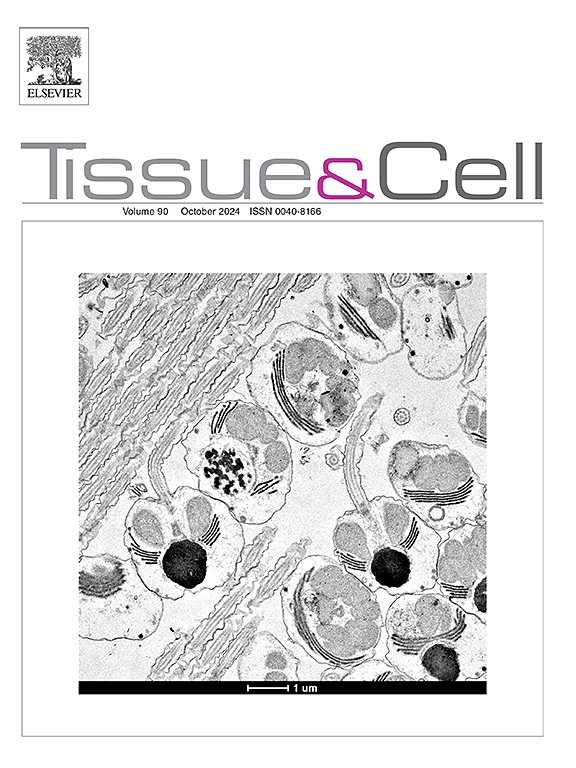Neutrophil extracellular traps-mediated upregulation of HIF-1α promotes corneal neovascularization
IF 2.7
4区 生物学
Q1 ANATOMY & MORPHOLOGY
引用次数: 0
Abstract
Objectives
The objective of this study is to examine the impact of neutrophil extracellular traps (NETs) on angiogenesis, both in vitro and in vivo contexts, as well as to elucidate the regulatory function of hypoxia-inducible factor (HIF-1α).
Methods
The study focused on investigating the regulatory function of HIF-1α in the induction of NETs formation. In vivo, following NaOH stimulation, the formation of NETs was quantitatively assessed through immunofluorescence staining employing specific markers, namely SYTOX Green and PicoGreen. Furthermore, mice were administered with HIF-1α, and seven days post-alkali burn, the formation of NETs in the cornea was evaluated by immunofluorescence staining techniques. Protein immunoblotting analysis validated an increase inHIF-1α expression within human umbilical vein endothelial cells (HUVECs) that were induced to form by NETs. In vitro, human neutrophils were subjected to HIF-1α treatment. Subsequent to NaOH stimulation, the NETs mesh was isolated and co-cultured with HUVECs. The migratory capacity and angiogenic potential of HUVECs were then quantitatively evaluated.
Results
Upon exposure to NaOH, a notable increase in SYTOX fluorescence was observed in neutrophils, indicative of the formation of a prominent network structure. Furthermore, a marked elevation in HIF-1α protein expression was detected in mouse corneal tissue that had undergone NETs formation, hinting at a potential role of NETs in mediating the up-regulation of HIF-1α. The outcomes of hematoxylin and eosin (H&E) staining, coupled with immunofluorescence staining, revealed an augmentation in neutrophils counts, with NETs exhibiting a marked potentiation of corneal neovascularization. In vitro assessments further demonstrated that HIF-1α played a stimulatory role in promoting the migration and tubular morphogenesis of HUVECs.
Conclusion
Exposure to sodium hydroxide serves as a trigger for the induction of NETs formation. NETs mediated an up-regulation of HIF-1α, which subsequently promotes angiogenesis and inflammatory activation in HUVECs. Consequently, this process leads to an enhancement of corneal neovascularization and inflammatory response.
中性粒细胞胞外陷阱介导的HIF-1α上调促进角膜新生血管形成
本研究的目的是研究中性粒细胞胞外陷阱(NETs)对体外和体内血管生成的影响,并阐明缺氧诱导因子(HIF-1α)的调节功能。方法研究HIF-1α在诱导NETs形成中的调控作用。在体内,NaOH刺激后,通过免疫荧光染色定量评估NETs的形成,使用特异性标记物SYTOX Green和PicoGreen。此外,小鼠给予HIF-1α,碱烧伤后7天,通过免疫荧光染色技术评估角膜内NETs的形成。蛋白免疫印迹分析证实了NETs诱导形成的人脐静脉内皮细胞(HUVECs)中inHIF-1α的表达增加。体外,人中性粒细胞接受HIF-1α处理。NaOH刺激后,将NETs网分离并与HUVECs共培养。定量评价HUVECs的迁移能力和血管生成潜力。结果暴露于NaOH后,中性粒细胞中SYTOX荧光明显增加,表明形成了明显的网络结构。此外,在发生NETs形成的小鼠角膜组织中检测到HIF-1α蛋白表达显著升高,提示NETs可能在介导HIF-1α上调中发挥潜在作用。苏木精和伊红(H&;E)染色,再加上免疫荧光染色,结果显示中性粒细胞计数增加,NETs显示出角膜新生血管的显著增强。体外实验进一步证实HIF-1α对HUVECs的迁移和小管形态形成具有促进作用。结论氢氧化钠暴露可诱发NETs的形成。NETs介导HIF-1α的上调,随后促进huvec的血管生成和炎症激活。因此,这一过程导致角膜新生血管和炎症反应的增强。
本文章由计算机程序翻译,如有差异,请以英文原文为准。
求助全文
约1分钟内获得全文
求助全文
来源期刊

Tissue & cell
医学-解剖学与形态学
CiteScore
3.90
自引率
0.00%
发文量
234
期刊介绍:
Tissue and Cell is devoted to original research on the organization of cells, subcellular and extracellular components at all levels, including the grouping and interrelations of cells in tissues and organs. The journal encourages submission of ultrastructural studies that provide novel insights into structure, function and physiology of cells and tissues, in health and disease. Bioengineering and stem cells studies focused on the description of morphological and/or histological data are also welcomed.
Studies investigating the effect of compounds and/or substances on structure of cells and tissues are generally outside the scope of this journal. For consideration, studies should contain a clear rationale on the use of (a) given substance(s), have a compelling morphological and structural focus and present novel incremental findings from previous literature.
 求助内容:
求助内容: 应助结果提醒方式:
应助结果提醒方式:


